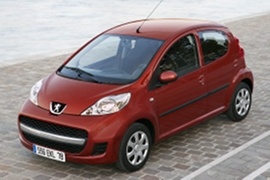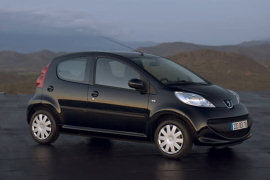PEUGEOT 107 5 Doors Models/Series Timeline, Specifications & Photos
First production year: 2005
Engines: Gasoline, Diesel
Body style: Hatchback
Developed in a joint-venture with Toyota, sharing both experience and costs, three vehicles came two life in 2005: the Peugeot 107, the Toyota Aygo and the Citroen C1. The trio was built in the Czech Republic and sold on the European market in the mini (A) segment.
Considering the Euro 5 emission standards starting with 2009, the carmakers had to refreshed their products. Peugeot refreshed the 107 as well, starting with 2008. Along with the introduction of cleaner engines, the Peugeot 107 received a redesigned, fresher exterior look.
The French brand adopted a feline-like shape for the car's headlights, with the main lamp bigger and cutting a slice from the hood. The front bumper was redesigned and featured fake side-scoops on the outer sides. Unlike the non facelifted version, the vertical bar placed in the middle of the grille was painted in silver.
Inside, depending on the trim-level, the 107 featured a tachometer mounted aside from the center speedometer, installed on the steering column assembly moving along when the driver adjusted its position. The center stack's simple layout allowed easy use of the HVAC controls—the 107 featured power windows at the front and a compass-based system for the rear ones.
Under the hood, Toyota provided the 1.0-liter gasoline engine and PSA (Peugeot-Citroen Group) the 1.4-diesel version. Both versions were paired as standard to a 5-speed manual, while a 5-speed automated version was available as an option. The latter consisted of a manual gearbox and a computer-controlled clutch-actuator system.
Peugeot and Citroen joined forces with Toyota to produce a series of supermini vehicles named 107, C1, and Aygo, respectively, in the modern factory from Kolin, in the Czech Republic.
While both automakers were experienced in producing small-sized vehicles, they knew that a joint venture would help them get a lower development and manufacturing cost. On the other hand, each brand had to come with its visual identity and a pricing policy that wouldn't affect its partners. It was a strange, cross-brand badge engineering situation that worked. At least for a while.
Peugeot created a similar brand identity to the one already promoted by the 206, which was on its last stint. That led to a smiling lower grille below the front bumper and no cooling grille above it. Moreover, the headlights were placed very high, and they almost touched the A-pillars due to their length. Despite its small size, the 107 was available in a five-door version, yet the rear doors were so narrow that the carmaker couldn't install rolling-down windows and had to use a pop-out system. Finally, at the back, Peugeot installed the big, triangular taillights on the C-pillars in a very high position to keep them safe from parking bumps and shopping carts.
Inside, there was hardly room for four adults, although the trio created these vehicles, especially for school runs. The cabin featured two seats at the front and a 50/50 split-folding bench in the back. The standard dashboard featured a speedometer and a fuel level gauge. The tachometer was offered as an option.
Under the hood, all three siblings shared the same engine, an inline-three, one-liter engine. That was paired with a standard five-speed manual or, as an option, an automated (robotized, single-clutch) gearbox.

